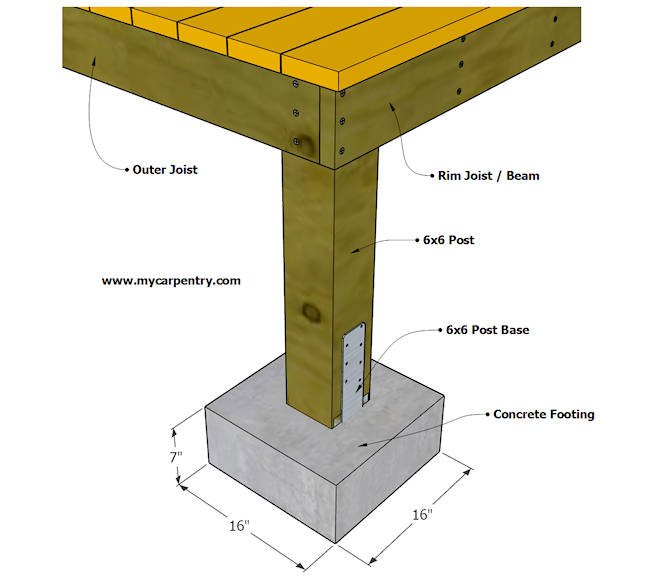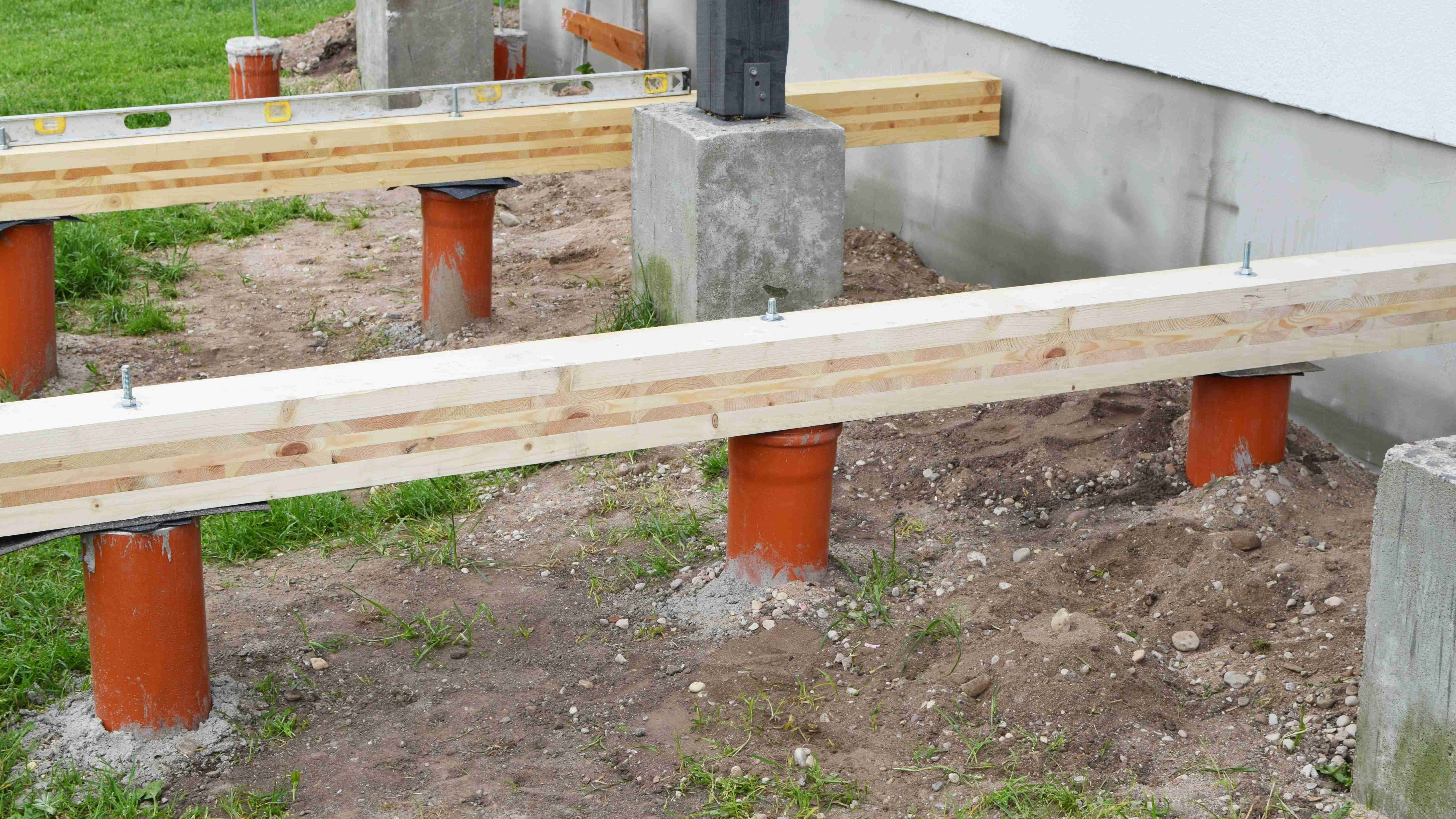Picking the Right Deck Footings for Security and Resilience
The longevity and safety and security of your deck depend heavily on the type of grounds you select, as they supply the important support and stability to endure the examination of time. In this discussion, we will explore the different types of deck grounds, consider the important factors to weigh when making a decision, and dig right into the pros and disadvantages of various options.
Types of Deck Grounds
There are a number of kinds of deck footings that can be made use of, each offering distinct advantages and factors to consider. One usual type of ground is the concrete pier footing. These footings include a round hole loaded with concrete, which provides a strong structure for the deck blog posts. Concrete pier footings are relatively simple to mount and supply exceptional security, making them a popular option for lots of deck tasks.
These footings are mounted by screwing them into the ground, which produces a safe foundation for the deck. They also permit for simple change and progressing of the deck if required.
Additionally, some contractors opt for precast concrete grounds. These footings are made of long lasting concrete and be available in various sizes and shapes to accommodate different deck layouts. Precast concrete footings are convenient to mount and give a secure base for the deck structure.
Finally, an additional option is the post-in-anchor ground system. This kind of ground includes driving a steel anchor right into the ground and connecting it to the deck message. It offers adaptability in terms of placing the deck posts and appropriates for decks with lightweight structures.
When picking the best kind of deck footing, it is important to consider variables such as soil problems, deck lots, and local structure codes (Deck Footings). Consulting with an expert contractor or architectural designer can help make sure the appropriate footing is selected for a secure and steady deck
Elements to Think About When Picking Grounds
When picking the appropriate footings for a deck, it is critical to thoroughly take into consideration different elements such as soil conditions, deck tons, and adherence to regional structure codes. These factors play a considerable role in ensuring the stability and resilience of the deck structure.
One of the main variables to think about is the dirt problems. The kind of dirt on which the deck will certainly be built establishes the kind of footings required. For instance, decks improved loosened or sandy soils may require deeper footings to offer sufficient assistance and avoid settling. On the various other hand, decks constructed on clay or large dirts might need footings that can fit the soil's tendency to expand and contract.
An additional vital variable is the deck lots. The weight of the deck, consisting of the materials utilized and any type of prospective online tons such as furnishings or events, need to be taken into consideration when choosing footings. The footings must be designed to birth the weight of the deck and distribute it equally to stop any type of structural concerns or failures.
Lastly, adherence to neighborhood building codes is critical. Building ordinance vary from area to region, and it is important to comply with the details requirements established by the local authorities. Deck Footings. These codes ensure that the deck is developed safely and satisfies the necessary criteria for structural honesty and load-bearing capacity
Concrete Grounds: Cons and pros

Concrete footings provide a number of benefits and disadvantages when utilized as the foundation for a deck. On the positive side, concrete footings supply excellent stability and toughness.
An additional advantage of concrete footings is their versatility. They can be poured right into different shapes and sizes to fit different deck styles and setups. Concrete grounds can be personalized to fit the certain demands and demands of the deck framework.
Nevertheless, there are likewise some disadvantages to using concrete footings. One significant negative aspect is the price and labor entailed in their setup. Concrete footings require excavation and typically need the assistance of heavy equipment. This can boost the general expense of the deck project and might need professional support.

Helical Piers Vs. Sonotubes: Which Is Better?
In taking into consideration the foundation options for a deck, the contrast in between helical piers and sonotubes is vital in determining the remarkable option. They are twisted into the ground using hydraulic machinery, giving a secure and sturdy foundation for the deck.
When it pertains to stability and durability, helical piers have the upper hand. The helical plates on the piers produce a solid grip with the soil, preventing any kind of movement or moving of the deck. This is especially advantageous in locations with unsteady or shifting dirt conditions. Sonotubes, on the various other hand, depend exclusively on the concrete filling for stability, which might not supply the same degree of stamina and resistance.
In terms of setup, helical piers are relatively much easier and faster to set up contrasted to sonotubes. The hydraulic equipment used to turn the piers right into the ground makes certain a fast and efficient procedure. Sonotubes, on the various other hand, need digging holes and putting concrete, which can be labor-intensive and time-consuming.
Additionally, helical piers are a more flexible choice. They can be utilized in different dirt conditions and can be adjusted or enhanced if needed. Sonotubes, on the various other hand, may need extra support, such as rebar, in specific soil conditions or areas with high tons needs.
Choosing the Right Footings for Your Deck's Measurements
For ideal architectural honesty, it is necessary to thoroughly pick the appropriate footings that line up with the measurements of your Deck Footings deck. The dimensions of your deck, including its elevation, size, and width, play a substantial function in identifying the type and size of grounds required.
When selecting footings for your deck, it is necessary to think about the load-bearing capacity of the dirt. The weight of the deck, integrated with the weight of any furniture or individuals on it, exerts a significant force on the footings (Deck Footings). For that reason, it is essential to select grounds that can sufficiently support this weight without sinking or moving gradually.
Larger decks with better measurements require bigger grounds to article supply sufficient security and support. The shape of the grounds, whether they are round or square, depends on the style and design of the deck.
Verdict
In verdict, selecting the appropriate deck footings is vital for ensuring stability and longevity. Aspects such as the type of footings, the deck's measurements, and the pros and cons of different options should be considered.
These grounds consist of a round opening filled with concrete, which offers a strong foundation for the deck blog posts. Concrete pier grounds are relatively simple to install and provide outstanding stability, making them a prominent choice for lots of deck jobs.
Precast concrete grounds are practical to install and supply a steady base for the deck framework.
It supplies adaptability in terms of positioning the deck messages and is suitable for decks with light-weight frameworks.
Concrete footings use numerous advantages and negative aspects when made use of as the foundation for a deck.
Comments on “Step-by-Step Deck Quality: Ensuring Stability with Appropriately Mounted Deck Footings”